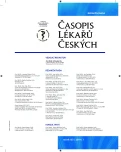Electromagnetic field intolerance: a nonexistent disease?
Authors:
Šárka Šafářová
Authors place of work:
Ústav lékařské etiky, Lékařská fakulta Masarykovy univerzity, Brno
Published in the journal:
Čas. Lék. čes. 2014; 153: 4-6
Category:
Přehledový článek
Summary
Idiopathic Environmental Intolerance Attributed to Electromagnetic Fields is a relatively new phenomenon, which is not fully understood. Extensive research has been carried out to exclude or confirm out that symptoms reported by sufferers are caused by electromagnetic field. This article describes outcomes of recent experiments and meta-analyses. The article may answer to the question if electromagnetic field does really cause reported symptoms, furthermore, it provides hypothetical explanation of this phenomenon.
Keywords:
electromagnetic hypersensitivity – electromagnetic field – nonspecific symptoms – nocebo effect
Zdroje
1. Genuis SJ, Lipp CT. Electromagnetic hypersensitivity: Fact or fiction? Science of the Total Environment 2012; 1 : 103–112.
2. Pekárek L. Hygiena práce - Informace NRL č. 14/2005, [online]. Hygienickástanice hlavního města Prahy. http://www.hygpraha.cz/odbory.php?ksum=MzA
3. Rubin GJ, Munshi JD, Wessely S. Electromagnetic Hypersensitivity:A systematic review of provocation studies. Psychosomatic Medicine 2005; 67 : 224–232.
4. Rubin GJ, Nieto-Hernandes R, Wessely S. Idiopathic environmental intolerance attributedto electromagnetic fields (formerly‘electromagnetic hypersensitivity’): an updated systematic review of provocation studies. Bioelectromagnetics 2010; 31 : 1–11.
5. Röösli M. Radiofrequency electromagnetic field exposure and non-specificsymptoms of ill health: a systematic review. Environmental Research 2008; 107 : 277–287.
6. Tuengler A, von Klitzing L. Hypothesis on how to measure electromagnetic hypersensitivity. Electromagnetic Biology and Medicine 2012; 1–10.
7. Baliatsas C, et al. Idiopathic environmental intolerance attributed to electromagnetic fields (IEI-EMF): A systematic review of identifying criteria. BMC Public Health 2012; 12 : 643.
8. Coolman AM. Oxford dictionary of psychology 3rd ed. Oxford: University Press 2009.
9. Dahmen N, Ghezel-Ahmadi D, Engel A. Blood laboratory findings in patients suffering from self-perceived electromagnetic hypersensitivity (EHS). Bioelectromagnetics 2009; 30 : 299–306.
10. Rubin GJ, Cleare AJ, Wessely S. Psychological factors associated with self-reported sensitivity to mobile phones. Journal of Psychosomatic Research 2008, 64 : 1–9.
11. Eltiti S, et al. Development and Evaluation of the Electromagnetic Hypersensitivity Questionnaire. Bioelectromagnetics 2007; 28 : 137–151.
12. Berglund F. Är elallergin verkligen en fobi? Läkartidningen 2001; 14 : 1719.
Štítky
Adiktologie Alergologie a imunologie Angiologie Audiologie a foniatrie Biochemie Dermatologie Dětská gastroenterologie Dětská chirurgie Dětská kardiologie Dětská neurologie Dětská otorinolaryngologie Dětská psychiatrie Dětská revmatologie Diabetologie Farmacie Chirurgie cévní Algeziologie Dentální hygienistkaČlánek vyšel v časopise
Časopis lékařů českých

- Barthův syndrom má první schválené léčivo, zatím v USA
- Neuropatie u diabetu: Proč ji nepřehlédnout a kdy myslet i na deficit vitaminů B?
- Ukažte mi, jak kašlete, a já vám řeknu, co vám je
- Metamizol jako analgetikum první volby: kdy, pro koho, jak a proč?
- Horní limit denní dávky vitaminu D: Jaké množství je ještě bezpečné?
Nejčtenější v tomto čísle
- Historické aspekty Smithovho-Lemliho-Opitzovho syndrómu
- Přecitlivělost na elektromagnetické pole: neexistující onemocnění?
- HELSINSKÁ DEKLARACE WMA – ETICKÉ ZÁSADY PRO LÉKAŘSKÝ VÝZKUM S ÚČASTÍ LIDSKÝCH BYTOSTÍ
- Súčasne dostupné kožné náhrady
